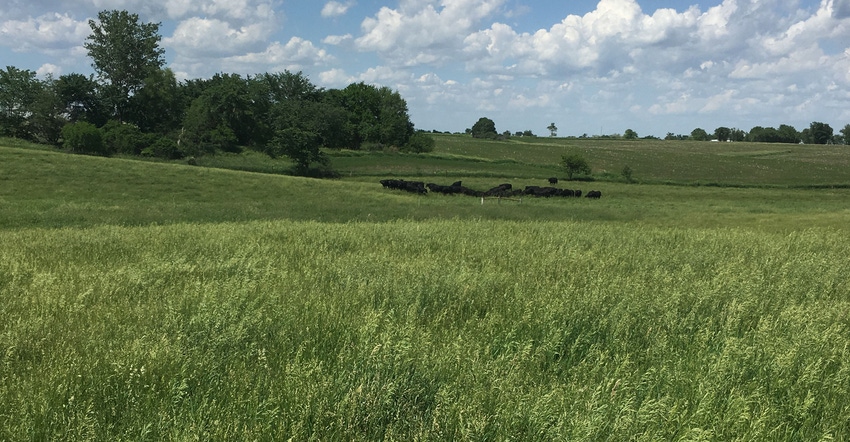April 21, 2021

Warming temperatures and spring rains have many pastures waking up from their winter hibernation and starting to green up. This brings up the conversation of whether or not to fertilize pastures before sending out animals to graze.
Pasture fertilization management is often guided by several considerations. These include:
forage production needs and timing
grass and legume species present
method of forage management
An important first step in this process is determining if there is a pH or nutrient deficiency by soil sampling and testing.
Good soil sampling
Soil sampling and testing is the only proper way to determine soil pH and nutrient deficiencies. It also allows us to fertilize for the crop needs without overfertilizing, which can pose an environmental risk. The key to soil testing is to collect a good representative sample of the pasture. So separate samples should be taken for different soil types, management areas and paddocks.
Care should be taken to avoid high traffic areas and areas where applying fertilizer may be difficult. Generally, soil sampling should be done every three to four years. This will allow growers to maintain optimum soil fertility levels.
More information on how to take a representative soil sample can be found in the publication, Take a good soil sample to help make good decisions, CROP 3108.
The pH guidelines for pastures can vary according to what species of grasses and legumes are present. Generally, most forage crops grow best when the soil pH is at least 6. The recommended pH for productive alfalfa and alfalfa-grass mixtures, however, ranges between 6.8 and 7. Liming has been shown to be a profitable practice, especially when needed to establish and maintain legumes in forage stands.
Additional information about optimum pH for forages and pastures, and about estimating amounts of lime to apply can be found in the publication, A General Guide for Crop Nutrient and Limestone Recommendations in Iowa, PM 1688.
After addressing any soil pH deficiencies, growers should turn their attention to nitrogen, phosphorus and potassium needs. Grasses can respond very quickly to N fertilization when other growing conditions are good. However, this may not be as profitable if P and K levels are inadequate.
Generally, most pastures are composed of "cool-season" grasses such as Kentucky bluegrass, smooth bromegrass, orchardgrass, fescue and reed canarygrass. Maximum growth of these species occurs during the spring, early summer and later again in the fall. Timely N fertilizer applications during these times can help increase total forage production, extend grass growth into early summer and stretch fall pasture production into early winter.
Application timing
Research has shown that split applications, compared to a single application of N, will improve the efficiency of N and the distribution of forage yield during the growing season. One-time applications typically occur in April to early May, with application rates of 60 to 100 pounds of N.
Split-applications typically occur in April, with application rates of 60 to 100 pounds, late spring with 30 to 50 pounds, and again in early fall with 40 to 70 pounds of N. Urea, ammonium sulfate, and UAN are common forms of N that may be used. A consideration to minimize any potential volatilization losses or leaf burning, is to make an application within a few days of an expected rain event.
An alternative for reducing the need for N fertilizer is to establish legumes in existing grass pastures. Legumes can be established in grasses by interseeding or frost-seeding. Additional information on these techniques can be found in the publications: Interseeding and No-till Pasture Renovation, PM 1097, and Improving Pasture by Frost Seeding.
Pastures that have been grazed and unfertilized may also test low in P and K levels. Yield responses to P and K applications are not as high as N applications for cool-season grasses. However, legume or legume-grass pastures have higher requirements for P and K. Adequate nutrient levels of P and K are also essential for legume establishment, maintenance and yield.
Fertilization rates should be based on nutrient level deficiencies and recommendations. This range may be from 25 to 75 pounds of P, and 50 to 140 pounds of K per acre, depending on soil deficiencies and expected nutrient removal rates.
Additional information about P and K fertilization for pastures can be found in the publication, A General Guide for Crop Nutrient and Limestone Recommendations in Iowa, PM 1688.
Improved pasture management
Weed control, as well as grazing timing and management, are other considerations to keep in mind for improved pasture management. Fertilizer applications will stimulate weed growth in a pasture. For this reason, it is necessary to mow, clip or spray weeds to control them before making any fertilizer applications. It should be noted that using broadleaf herbicides on legume and mixed legume-grass pastures will injure the legumes, so these types of pastures should be only be mowed, clipped or spot-sprayed in the worst areas.
For best fertilizer response, delay spring grazing until pastures have been growing for at least two to three weeks. Avoiding continual grazing, switching between pastures or paddocks, and maintaining at least 3 to 4 inches of pasture growth will allow pastures to recover much quicker. Grazing should be controlled to maintain pasture stand vigor and densities. Thick stands of grasses and legumes will not only improve forage quantity and quality, but will also control future weed pressure.
The best returns from pasture fertilization will depend on effective utilization through well-managed livestock and forage programs. Fertilization is important in any efficient, highly productive forage program. Years of research and farmer experience have demonstrated large increases in days of grazing, annual gain or milk production per acre by fertilizing low-yielding pastures.
Also, rotational grazing, with sequential rest or recovery periods during the grazing season are important if fertilizer benefits are to be fully realized. Additional information about fertilizing pastures can be found in the publication, Fertilizing Pasture, PM 869.
Michel is an ISU Extension field agronomist covering northeast Iowa. Contact him at [email protected].
About the Author(s)
You May Also Like






